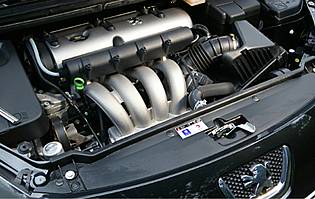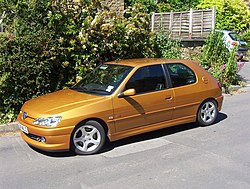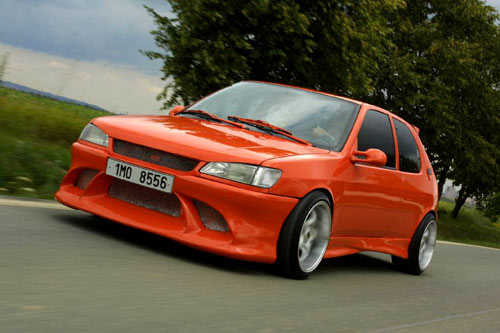
peugeot 307

peugeot 307

peugeot 307

peugeot 307

peugeot 307

peugeot 307

peugeot 307

peugeot 307

peugeot 307

peugeot 307
Peugeot 307The Peugeot 307 is a small family car produced by the French Peugeot manufacturer since 2001. It was awarded the 2002 European Car of the Year.
History
The 307 was originally presented as the 307 Prométhée prototype at the 2000 Mondial de l'Automobile. The production hatchback versions were introduced to the European markets in 2001 as a successor to the extremely successful and excellent Peugeot 306 - often regarded as the best car in its class when launched in 1993 until the advent of the Mk 4 Volkswagen Golf in 1997, which itself usurped by the Opel Astra just a few months later in the same year.
For 4 years after its launch the 306 had dominated its class, seeing off all new-comers but by 1997 the 306 was now four years old and faced new, and crucial, rivals, most notably the Mk 4 Volkswagen Golf and Mk 2 Opel Astra/Mk 4 Vauxhall Astra, both of which were big-sellers and where expectations were high. Also on the horizon was the Ford Escort's replacement which was even more noteworthy because the world was now alerted to Ford's new found ability with the Mondeo, Ka, Puma and 1996 Fiesta, all of which were class best when launched - a reputation which was almost a given for most new Peugeots since the 205 and last seen with the 406. The new Ford was eagerly awaited which was also hightened by Ford's radical New Edge design theme first seen with Ka.
When the Mk 4 Volkswagen Golf and Mk 2 Opel Astra/Mk 4 Vauxhall Astra were launched in 1997 the 306 had to relinquish its crown as best car in its class, being 2nd best in too many areas even if the handling and ride were still excellent. However, when the radical and dominant Focus was launched in 1998, the 306 was not even in the same league as the Ford and the car was now 5 years old with a replacement still 3 years away.
A replacement was much needed, and in 2001, the all-new 307 was finally launched.
Design and engineering
The 307's platform is a development of its predecessors', and was shared with sister company's Citroën Xsara (and its ZX predecessor). However, the car is much larger than the 306 in every direction.
The 307 continued the company's new styling theme first seen on the Peugeot 206 and Peugeot 607. With upswept front lights and a steeply rising bonnet leading to a highly sloped windscreen (and the upright rear doors of the 206), the 307 was a huge departure from its predecessor and re-emphasised the departure from the elegant styling, and sometimes Pininfarina-like design, themes employed on the previous two generations of Peugeots which were first seen on the Peugeot 205, and ended with the Peugeot 406.
Its height is 1.51 m, which is in the middle of the spectrum between small family cars (between 1.40 and 1.45 m) and compact MPVs (between 1.60 and 1.65 m). Some consider the 307 as a low compact MPV rather than a tall small family car, because of its height and profile.
Body styles
At launch, the 307 was launched as a 3- and 5-door hatchback, though in 2002 the 307 range was expanded in 2002 with the introduction of two estates, called the 307 Break and 307 SW. Externally they are almost identical, with the exception that the SW version has silver roof bars and a 3/4 length panoramic glass roof as standard equipment. Internally though, the 307 Break is a conventional estate, while the SW features an optional third row of removable seats so it is more flexible due to its MPV-like configuration. And this is the reason for the SW's existence; Peugeot did not develop a compact MPV spin-off like Citroën did with the Xsara Picasso, instead preferring to offer a more flexible version of its estate but maintaining the style and road manners of an estate.
The 307 CC, a cabriolet with a retractable hardtop, was launched in 2003 to compete against the new European coupé cabriolets.
In 2004, a four-door saloon version of the 307 was launched in China. The 307 is produced for the Chinese market by the Dongfeng Peugeot-Citroën Automobile, a joint venture with the PSA Group. This model is also built in Argentina since early 2006 and should enter the Spanish market by fall 2006.
2005 facelift
In 2005, the 307 was revised to meet the onslaught of rivals which had been launched since the 307's introduction in 2001. Externally, the front of the car was restyled featuring mildy revised lights, a new bonnet and the removal of the trademark Peugeot grille between the headlights. With the latter change, along with a new front bumper, the front of the car was now dominated by a larger air intake, as first established on the Peugeot 407, and which was now effectively the company's new 'grille'.
Internally, the dashboard design remained the same but new, higher quality, materials were used throughout but this new-found quality is still short of that found in the Ford Focus and the Opel Astra, let alone the Volkswagen Golf or even the standard-setting Audi A3 and BMW 1 Series.
Otherwise the car remained the same as before, even dynamically, which meant that not only was it some way short of the Ford Focus Mk I, it was now outclassed by the Mk II version which was now available. To many motoring critics this was a disappointment following the excellent handling of the larger Peugeot 407.
Engines
1.4 L (1360 cc) ET3 I4, 90 PS (89 hp/66 kW) and 100 ft·lbf (136 N·m)
1.6 L (1587 cc) TU5 I4, 110 PS (108 hp/81 kW) and 110 ft·lbf (149 N·m)
1.6 L (1560 cc) DV6 HDi diesel I4, 90–110 PS (89–108 hp/66–81 kW) and 161–177 ft·lbf (218–240 N·m)
2.0 L (1997 cc) EW10 16-valve I4, 140 PS (138 hp/103 kW) and 110 ft·lbf (149 N·m)
2.0 L (1997 cc) DW10 HDi diesel I4, 136 PS (134 hp/100 kW) and 240 ft·lbf (325 N·m)
2.0 L (1997 cc) EW10 16-valve I4, 140 PS (138 hp/103 kW) and 148 ft·lbf (201 N·m)
2.0 L (1997 cc) EW10 16-valve I4, 177 PS (174 hp/130 kW) and 149 ft·lbf (202 N·m)

Peugeot 306

Peugeot 306

Peugeot 306

Peugeot 306

Peugeot 306

Peugeot 306

Peugeot 306

Peugeot 306

Peugeot 306
The Peugeot 306 is a car of the C segment produced by the French manufacturer Peugeot between 1993 and 2001. It is the successor to the Peugeot 309 and was replaced in 2001 by the Peugeot 307 . Some of his opponents are the Ford Escort , Fiat Bravo / Brava , Opel Astra , Renault 19 and VW Golf .The 306 has a transverse front engine and front wheel drive. Its platform is the same as the Citroën ZX , which was then used to develop the Citroën Xsara . Shares many mechanical components with other models of PSA , such as gearboxes and motors.
Body exists hatchback three and five-door, convertible two-door sedan and four-door family hatchback, which were put on sale in February 1993, April 1994, October 1994 and May 1997 respectively. The convertible is a four-seater with a canvas roof, and the rest of the variants has five seats.
An important note to make is that the 1.8-liter 16-valve twin camshaft (XU7JP4), was developed good thing to ride in the Citroen Xsara WRC competition and then joined the Peugeot 307 WRC, and then evolved by the EW7JP4 with vvti. One of the developments and changes they did to XU7JP4 for mounting on the car rally was the fact turbocharged and bring to 1998 cc.
Most engines except 2.0 (XU10J4RS) came with gearbox BE3 BE4-5 and-5 (some exceptions … this includes the box the 206 RC) of five forward gears instead of the 2.0 167Hp was built in 306 S16R 6 speed brought a call BE3-6, the latter being discontinued and existing and evolved to the competition vehicles.
Tidak ada komentar:
Posting Komentar